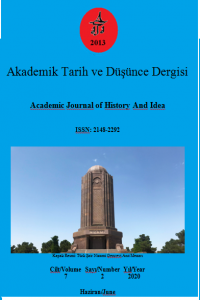A general view of South Azerbaijani poet Sahand’s reativity
South Azerbaijani literature, Bulud Garachurlu Sahand, Pahlavi regime, assimilation policy
A general view of South Azerbaijani poet Sahand’s reativity
South Azerbaijani literature, Bulud Garachurlu Sahand, Pahlavi regime, assimilation policy,
___
- Akpınar, Y. (1985). Bulut Karaçorlu Sehend ve Bazı Şiirleri. Araştırma Dergisi, 13, 379-399.
- Əliyeva, X. (2007). Dədə Qorqud obraz və süjetləri bədii ədəbiyyatda. filologiya elm. namiz. [Dis.avtoreferatı, AMEA Nizami adına Ədəbiyyat İnstitutu).
- Mededi, İ.O. (2003). Bulud Karaçorlu Sehendin hayatı ve eserleri üzerinde bir araştırma [Yüksek Lisans Tezi, Ege Üniversitesi].
- Sehend. (2015). Dedemin kitabı. (Haz. F. Süleymanoğlu). Nurlar.
- Sehend. (2001). Dedemin kitabı (Red. M. Fərzanə). Durna och Tribun.
- Sehend. (2010). Divan. (Haz. E. Sədiq). Tehran.
- Sehend. (2012). Qardaş andı. Haz.S. Muğanlı). Afkar.
- Sehend. (2006) Seçilmiş eserleri. ( Haz. R. Qanbarqızı, ).Şarq-Qarb.
- Sehend. (2006) Seçilmiş eserleri. Haz Qanbarqızı, R/, Bakı, Şarq-Qarb.
- Serrafi, ƏA. (1998). İranda “Dede Qorqud” kitabının tanınması ve naşri tarixindan. Varlıq.
- Süleymanoğlu, F. (2020). İran`da Azerbaycan türkçesi sorunu ve Sehend`in konuya bakış açısı. Türk Kültürü ve Medeniyeti Araştırmaları Dergisi, 1. https://dergipark.org.tr/tr/download/article-file/978251
- Yayın Aralığı: Yılda 6 Sayı
- Başlangıç: 2013
- Yayıncı: Hakan YILMAZ
Yavuz Selim BALCIOĞLU, Kültigin AKÇİN, Umit BAYRAKTAR
Erzurum Eyaletinde 1742-1800 Yılları Arasında Güvenlik Sorunları
İkram AĞASİYEV, Seyid MƏMMƏDZADƏ
Cereyan Filminin Göstergebilimsel Çözümlemesi
Emrah DANIŞ, Mustafa KARATAŞ, Ali GÜVEN, Hasan NAZLI, Habibe KAHRAMAN
Arşiv Belgelerine Göre Uluslararası Oslo Kongresi
XVII. Yüzyılın İkinci Yarısı-XVIII. Yüzyılın Başlarında Osmanlı-Avusturya İlişkileri ve Macaristan
Baas Partisi Döneminde Irak-Suriye İlişkilerinin Özellikleri
Şiirleri Bestelenen Sultan Şairler ve Sultanlarda Peygamber Sevgisi
Talha GÜNAYDIN, Mirac Betül KAPTAN
Taşımalı Eğitimde Nöbetçi Öğretmenlerin Karşılaştığı Sorunlar
Metin KAN, Osman ALATAŞ, Semra MENGÜÇ, Turgay ÇINAR, Talip KARAALP, Yeşim SANAL, Mustafa Özgür KURTOĞLU
